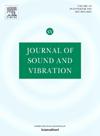Investigation of a novel magnetic inerter-based absorber under shock load
IF 4.3
2区 工程技术
Q1 ACOUSTICS
引用次数: 0
Abstract
Inerter-based absorbers have proven exceptionally effective in dampening vibrations within a specific low-frequency range, thus finding widespread application in engineering. However, their performance under shock loads poses a more intricate challenge, demanding the development of structures that can encompass a broader spectrum of vibration reduction frequencies. This paper introduces the magnetic inerter shock absorber (MISA), a groundbreaking approach that addresses this challenge. The cornerstone of the MISA lies in the ingenious linkage of its additional mass to the base. This design minimizes the influence on the payload while achieving an astounding amplification factor of thousands. Once integrated into a single-degree-of-freedom system, comprehensive nonlinear motion differential equations are formulated to capture the dynamics triggered by shock loads. Utilizing Fourier analysis, the shock loads are decomposed, and the harmonic balance method is employed to obtain the analytical structure of the system. Following this, numerical solutions are derived via the shock alternating frequency time method, providing insight into the ultimate dynamic response. The results demonstrate that the MISA swiftly suppresses residual vibrations while attenuating transient responses. Finally, an experimental verification confirms the MISA’s ability to reduce shock vibrations. This work not only introduces a novel solution for mitigating the shocks of transient vibrations and residual oscillations induced by shock loads, but also provides guidance for implementing advanced vibration control by adjusting the rotational damping ratio.
新型磁性电抗器吸收器在冲击负荷下的研究
事实证明,基于电抗器的吸收器在特定低频范围内的减振效果极佳,因此在工程领域得到了广泛应用。然而,它们在冲击载荷下的性能提出了更复杂的挑战,要求开发出能涵盖更宽减振频率谱的结构。本文介绍了磁性插入式减震器(MISA),这是一种应对这一挑战的开创性方法。MISA 的基石在于其附加质量与底座的巧妙连接。这种设计最大限度地减少了对有效载荷的影响,同时实现了惊人的数千倍放大系数。一旦集成到单自由度系统中,就会制定全面的非线性运动微分方程,以捕捉冲击载荷触发的动态。利用傅立叶分析法对冲击载荷进行分解,并采用谐波平衡法获得系统的分析结构。随后,通过冲击交变频率时间法得出数值解,从而深入了解最终的动态响应。结果表明,MISA 能够迅速抑制残余振动,同时减弱瞬态响应。最后,实验验证证实了 MISA 减少冲击振动的能力。这项工作不仅为减轻冲击载荷引起的瞬态振动和残余振荡的冲击引入了一种新的解决方案,而且还为通过调整旋转阻尼比实施高级振动控制提供了指导。
本文章由计算机程序翻译,如有差异,请以英文原文为准。
求助全文
约1分钟内获得全文
求助全文
来源期刊

Journal of Sound and Vibration
工程技术-工程:机械
CiteScore
9.10
自引率
10.60%
发文量
551
审稿时长
69 days
期刊介绍:
The Journal of Sound and Vibration (JSV) is an independent journal devoted to the prompt publication of original papers, both theoretical and experimental, that provide new information on any aspect of sound or vibration. There is an emphasis on fundamental work that has potential for practical application.
JSV was founded and operates on the premise that the subject of sound and vibration requires a journal that publishes papers of a high technical standard across the various subdisciplines, thus facilitating awareness of techniques and discoveries in one area that may be applicable in others.
 求助内容:
求助内容: 应助结果提醒方式:
应助结果提醒方式:


